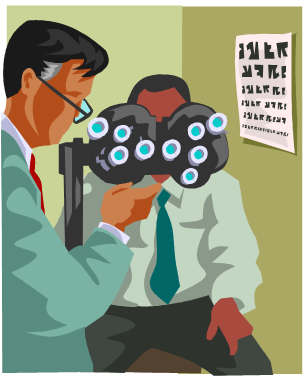 Every year, I visit my friend the optometrist. One thing that I can count on is answering a lot of black and white questions as I stare through various lenses. You know the routine. Is this one better? Or, is this one better? Over and over again the black and white decision is required. This is how my doctor narrows down the choices about which lens will provide the best correction for each of my eyes. That way, he will know precisely what eye glass prescription that I should have.
Every year, I visit my friend the optometrist. One thing that I can count on is answering a lot of black and white questions as I stare through various lenses. You know the routine. Is this one better? Or, is this one better? Over and over again the black and white decision is required. This is how my doctor narrows down the choices about which lens will provide the best correction for each of my eyes. That way, he will know precisely what eye glass prescription that I should have.
Are black and white questions the best type of questions for business strategists?
The virtue of a black and white question is that the answer is succinct and distinct. There isn’t debate about whether we should develop a new product since the answer is “yes” or “no.” We don’t endlessly wonder about entering a new market because we can get a concrete answer quickly. New trends are less worrisome because we decide simply whether they will happen or they won’t. Nice. Tidy. Quick. And dangerously simple.
![]()
Strategy is best dealt with in grayscales
A grayscale implies that there are gradients. Gradients, in turn, imply that the future is blend of influences. Intuitively we recognize that this is true at work. Seldom do major decisions get made with a simple yes or no. There are debates, arguments, counter proposals and reflection. After much gnashing of teeth, an answer finally emerges. The effective strategist eschews the simplicity of black and white thinking and chooses to live in the gray zone. How is this done?
Banking on “it depends”
My graduate school professor once told me that the right answer to any complicated question is “it depends.” Amazingly, as I have practiced this in my work life, these two words often served to silence those that were trying to trap me into black and white thinking. My opponents retreated to attack another day when I might ignore the fact that life and strategy is complicated. (May their wait truly be long.)
Of course, the right retort would have been “it depends on what?” This is where a strategist makes money. For example, will mobile banking become a significant, consumer demanded service in the future? Snapshot answers (e.g., is it important today, will it be important in 2012) may be “yes” or “no”. More helpful are the answers which explain what has to be in place (e.g., technology, business models, competitive forces, etc.) for this type of service to be broadly available and seen as a differentiator in the market. This is less like a snapshot and more like a constantly changing movie. When all of the components of the “movie” are identified, then the strategist can make arguments, assemble evidence and track competitors with respect to those components.
Shift the question from “what” to “when”
Think for a moment about baseball. One of the hardest things to do in sports is to hit a baseball. It requires many skills including good hand-to-eye coordination, proper balance and superb eyesight. Still, the most important determinant of getting a good hit is timing. The batter has to time the arrival of the pitch (and its trajectory) with precision or else failure is almost certain. This is why pitchers (i.e., their competitors) are fundamentally trying to upset the batter’s timing. And, not surprisingly, the very best hitters fail almost seventy percent of the time.
Strategy is similar. It very often is about timing when a market will mature or when a specific product investment should be made. It’s about tracking the moves of competitors and understanding when their offerings will endanger your competitive position. It’s about using dynamic market feedback of all sorts to adjust the speed of responses and initiatives. (Sometimes we should go faster and sometimes we should go slower.) It’s about having a fine tuned sense of those critical dependencies and meshing them together (using models and other tools) in such a way that they can be viewed for discussion and debate.
Here are some reminders to get you to the strategist’s gray zone (and keep you there)
1. Practice responding “it depends” to questions about the future
2. Be ready to explain the dependencies
3. Put things in place to monitor the dependencies over time as they change
4. Create a model to show how the dependencies fit together and affect your business
5. Regularly hypothesize possible competitive responses
My eye doctor can prescribe vision correction lenses. His methods work assuming that I actually wear the glasses that he prescribes. Though it may be counter intuitive at first, the strategist’s gray zone is actually much clearer and more valuable than the black and white world. Though it does not guarantee success, it does produce strategy that is richer and more effective than other mindsets.
Do you agree?

no comment until now